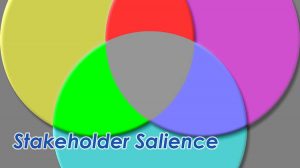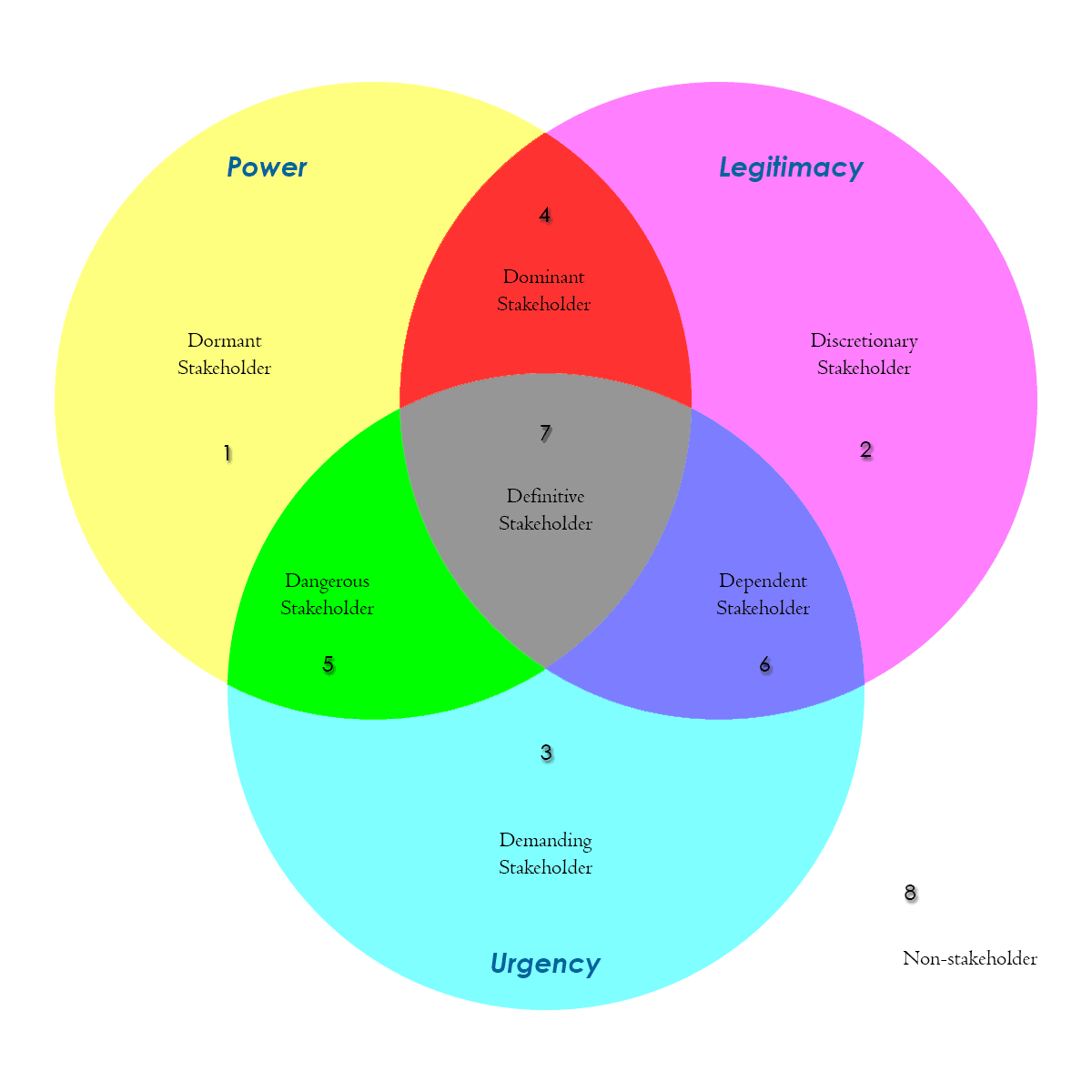 Using the Salience Model will be the subject of this second part exploration of using the technique in your stakeholder analysis practice. The theory and background is covered in Stakeholder Analysis and the Salience Model – Part 1: What is the Model. The combination of the analysis of power, legitimacy, and urgency of a proposed stakeholder yields their salience. Based on their salience we can determine the quality of interaction that the management of a project needs to apply to competing stakeholder claims or relationships. Succinct said: salience informs the project of which entities have the greatest ability to affect the outcome of the project, and the character of that effect may take.
Using the Salience Model will be the subject of this second part exploration of using the technique in your stakeholder analysis practice. The theory and background is covered in Stakeholder Analysis and the Salience Model – Part 1: What is the Model. The combination of the analysis of power, legitimacy, and urgency of a proposed stakeholder yields their salience. Based on their salience we can determine the quality of interaction that the management of a project needs to apply to competing stakeholder claims or relationships. Succinct said: salience informs the project of which entities have the greatest ability to affect the outcome of the project, and the character of that effect may take.
This second part of the article will cover how to use the technique in practice.
Determining salience entails going through the list of proposed stakeholders and deciding if they possess power, legitimacy, or urgency attributes. The results of this analysis will tell you the level salience (impact) and category (character) for the stakeholder. To more fully understand how this works it helps to visualize these characteristics on a Venn Diagram:

What Level are You Up To?
There are four levels which represent the amount of impact that a stakeholder will likely have on a project. The more attributes are possessed the more important they will be to the success of the project. The four levels represent all the possible values from no attributes to all attributes.
Salience accumulates as a stakeholder possesses increasing number of attributes. These levels are characterized as:
- Non-Stakeholders – These entities really aren’t stakeholders as they possess none of the attributes of power, legitimacy, or urgency. As a project manager, it is a good idea to be aware of them as at some point, during the identification process, they were thought important enough to have been at least mentioned. Otherwise, they can be safely ignored as part of risk, communications, and stakeholder management planning.
- Latent – These entities possess only one of the three potential attributes. As such, they will be unlikely to affect any impact and likely to be uninterested in project. Similar to non-stakeholders, a latent stakeholder need not occupy much of your time as a project manager. None the less, they should be at least kept in mind as they do have a relationship to the project, albeit one of little salience.
- Expectant – When a stakeholder possesses two of the three attributes they are said to be expectant as they will anticipate influencing the project. Unlike the latent level, an expectant stakeholder becomes active and the quantity of effort applied to manage the expectations of such entities must be increased accordingly. Additionally, there is a possibility that an expectant entity will be looking for ways to achieve the missing third salience attribute. Specific understanding and planning are recommended for this level of stakeholding entity.
- Definitive – When an entity possesses all three of the attributes they are then a definitive stakeholder and therefore highly salient and influential to the project. In preparing your risk, stakeholder, and communications management plans the needs of definitive stakeholders must be explicitly elucidated.
The Character Is in the Category
In addition to the four levels of salience, there are seven intersecting categories on the Venn Diagram. An eighth category possessing no attributes, representing “non-stakeholders”, is shown outside the diagram. The categories, represented by the intersection of possessed attributes, identify the character of the entity’s relationship to the project. Clues are provided by the salience category which indicates how the entity will need to be managed.
The salience categories are:
✓ Power
✓ Legitimacy
✓ Urgency
✓ Power
✓ Legitimacy
✓ Power
✓ Urgency
✓ Legitimacy
✓ Urgency
✓ Power
✓ Legitimacy
✓ Urgency
How to Put it All Together
The primary input for Salience Model analysis is a list of proposed stakeholders gleaned from the project charter, discussions with sponsors and identified participants, artifacts from previous similar projects, or other sources. When first identifying potential stakeholders, it is best to cast a wide net, erring on the side of inclusion. After that has been completed disciplined analysis techniques should be used to identify non-stakeholders and understand the impact of other entities on the project. The Salience Model is a powerful tool to determine “Who and What Really Counts”, however it is recommended that other tests be employed as well. There are a number or other techniques recommended in the PMBOK Guide .
The first thing to do is to go through the Stakeholder Register and determine whether each entity list has any of the attributes of power, legitimacy, or urgency. The initial analysis should be based on the frame of reference of the product output of the project, i.e. whatever it is that is being built by the project effort.
As we know, one of the things that never changes on a software project is change. That everything is mercurial indicates that salience assessments are dynamic too. The values of the attributes will change and should be considered at specific times during the execution of the project. As part of initial planning, salience and other stakeholder analysis should be considered for major milestones in the project. Part of stakeholder, risk, and communications planning should note stakeholders that are likely to change their character so they can be monitored correctly.

Download the Salience Model worksheet and we’ll walk through the analysis. The sheet is a stripped-down stakeholder register. You should include the columns needed for salience analysis in whatever stakeholder register you currently use. The spreadsheet is structured as follows:
The columns ‘C’, ‘D’, and ‘E’ are used to record your assessment of the stakeholder’s salience attributes of Power, Legitimacy, and Urgency, respectively. The cells are restricted to the values ‘Y’ or ‘N’ to determine the salience level or category.
Column ‘F’ calculates the salience level based on the attributes entered. It references a range of cells on the “Lookup Values” sheet.
Column ‘G’ calculates the salience category according to the attributes entered. Like the “Salience Level” column, the formula in the “Salience Category” column looks up the category from a range of cells in the “Lookup Values” spreadsheet. These formulas will check to see that all of the values are correctly entered before performing the lookup.
If you are going to use the formulas in your own stakeholder register, make sure you have a sheet named “Lookup Values” in the workbook configured correctly. You will likely need to change the formulas to reference the correct attribute columns if they are not the same as on the example download.
Wrapping Up the Salience Model
That covers the salience model and its usage sufficient for practice as a project manager. As mentioned above, salience analysis should be a part of your overall stakeholder analysis and not the only tool you use. Getting your stakeholder management correct is critical to the success of your project. It is not just managed as part of the Stakeholder Management process group but incorporated into the Communions and Risk process groups. We’ll cover these techniques in future posts.
References:


An excellent reference and guide to using the model. Thank you
Thanks Paul. Much appreciated.
Thanks